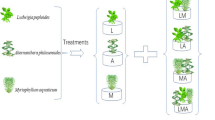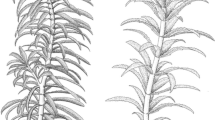Abstract
Invasive aquatic plants constitute a great problem in many freshwater systems. Although many studies have addressed the potential threats of invasion by exotic species in aquatic ecosystems, few studies have considered the interactions (competition, facilitation, coexistence) between exotic aquatic plants of similar growth form in invaded communities. Our aim was to investigate experimentally the effect of density in monocultures and the effect of neighbour identity and plant density on a focal species in mixed cultures. We used Elodea canadensis, Egeria densa and Lagarosiphon major as model species and conducted two experiments, one in a monoculture and another in a mixed culture following an additive design. Individuals were planted in pots with several treatments based on the identity and density of neighbour species. Our results demonstrated that the development of an invasive submerged plant could be influenced either positively (facilitation) or negatively (competition or inhibition) by the presence of more than one neighbour species of different densities. An increase in density significantly stimulated competition intensity, although the effect of density on the performance of the invader also depended on neighbour identity. A facilitative effect of E. canadensis on the apical growth of E. densa was established. However, despite these results, the competitive outcome also depended on other environmental factors (e.g. underwater radiation), not on plant density and neighbour identity alone.



Similar content being viewed by others
References
Aguiar MR, Lauenroth WK, Peters DP (2001) Intensity of intra- and interspecific competition in coexisting shortgrass species. J Ecol 89:40–44
Anderson MJ (2001) Permutation tests for univariate or multivariate analysis of variance and regression. Can J Fish Aquat Sci 58:626–639
Barrat-Segretain MH, Elger A (2004) Experiments on growth interactions between two invasive macrophytes species. J Veg Sci 15:109–114
Clayton J, Edwards T (2006) Aquatic plants as environmental indicators of ecological condition in New Zealand lakes. Hydrobiologia 570:147–151
Cook CDK, Urmi-König K (1984) A revision of the genus Egeria (Hydrocharitaceae). Aquat Bot 19:73–96
Cook CDK, Urmi-könig K (1985) A revision of the genus Elodea (Hydrocharitaceae). Aquat Bot 21:111–156
Creed JC, Norton TA, Kain JM (1997) Intraspecific competition in Fucus serratus germlings: the interaction of light, nutrient and density. J Exp Mar Biol Ecol 212:211–223
Dugdale TM, Clements D, Hunt TD, Butler KL (2012) Survival of a submerged aquatic weed (Egeria densa) during lake drawdown within mounds of stranded vegetation. Lake Reser Manag 28:153–157
Gérard J, Natacha B, Ludwig T (2014) Effect of water column phosphorus reduction on competitive outcome and traits of Ludwigia grandiflora and L. peploides, invasive species in Europe. Aquat Invas 9:157–166
Hofstra DE, Clayton J, Green JD, Auger M (1999) Competitive performance of Hydrilla verticillata in New Zealand. Aquat Bot 63:305–324
Howard-Williams C, Clayton JS, Coffey BT, Johnstone IM (1987) Macrophyte invasions. In: Viner AB (ed) Inland waters of New Zealand DSIR bulletin, vol 241. Department of Scientific and Industrial Research Science Information Publishing Centre, Wellington, pp 307–331
James CS, Eaton JW, Hardwick K (1999) Competition between three submerged macrophytes, Elodea canadensis Michx, Elodea nuttallii (Planch) St John and Lagarosiphon major (Ridl) Moss. Hydrobiologia 415:35–40
James CS, Eaton JW, Hardwick K (2006) Responses of three invasive aquatic macrophytes to nutrient enrichment do not explain their observed field displacements. Aquat Bot 84:347–353
Kolada A, Kutyta S (2016) Elodea canadensis (Michx.) in Polish lakes: a non-aggressive addition to native flora. Biol Invasion 18:3251–3264
Les DH, Moody ML, Soros CL (2006) A reappraisal of phylogenetic relationships in the monocotyledon family Hydrocharitaceae (Alismatidae). Aliso 22:211–230
Markham JH, Chanway CP (1996) Measuring plant neighbour effects. Funct Ecol 10:548–549
Martin GD, Coetzee JA (2014) Competition between two aquatic macrophytes, Lagarosiphon major (Ridley) Moss (Hydrocharitaceae) and Myriophyllum spicatum Linnaeus (Haloragaceae) as influenced by substrate sediment and nutrients. Aquat Bot 114:1–11
McCreary JN (1991) Competition as a mechanism of submersed macrophyte community structure. Aquat Bot 4:177–193
Mckee D, Hatton K, Eaton JW, Moss B (2002) Effects of simulated climate warming on macrophytes in freshwater microcosm communities. Aquat Bot 74:71–83
Moen RA, Cohen Y (1989) Growth and competition between Potamogeton pectinatus L. and Myriophyllum exalbescens Fern. in experimental ecosystems. Aquat Bot 33:257–270
Mony C, Koschnick TJ, Haller WT, Muller S (2007) Competition between two invasive Hydrocharitaceae (Hydrilla verticillata (L.f.) Royle and Egeria densa Planch) as influenced by sediment fertility and season. Aquat Bot 86:236–242
Rahel FJ, Olden JD (2008) Assessing the effects of climate change on aquatic invasive species. Conserv Biol 22:521–533
R Core Team (2016) R: a language and environment for statistical computing. R Foundation for Statistical Computing. https://www.R-project.org/
Redekop P, Hofstra D, Husser A (2016) Elodea canadensis shows a higher dispersal capacity via fragmentation than Egeria densa and Lagarasiphon major. Aquat Bot 130:45–49
Ren MX, Zhang QG (2009) The relative generality of plant invasion mechanisms and predicting future invasive plants. Weed Res 49:449–460
Ribaudo C, Tison-Rosebery J, Buquet D, Jan G, Jamoneau A, Abril G, Anschutz P, Bertrin V (2018) Invasive aquatic plants as ecosystem engineers in an Oligo-Mesotrophic shallow lake. Front Plant Sci 9:1781
Riis T, Olesen B, Clayton JS, Lambertini C, Brix H, Sorrell B (2012) Growth and morphology in relation to temperature and light availability during the establishment of three invasive aquatic plant species. Aquat Bot 102:56–60
Santos MJ, Anderson LW, Ustin SL (2011) Effects of invasive species on plant communities: an example using submersed aquatic plants at the regional scale. Biol Invasion 13:443–457
Silveira MJ, Thiébaut G (2017) Impact of climate warming on plant growth varied according to the season. Limnologica 65:4–9
Silveira MJ, Chollet S, Thiébaut G, Thomaz SM (2018) Abiotic factors, not herbivorous pressure, are primarily responsible for the performance of an invasive aquatic plant. Ann Limnol Int J Lim 54:12
Sousa WTZ, Thomaz SM, Murphy KJ (2010) Response of native Egeria najas Planch. and invasive Hydrilla verticillata (L.f.) Royle to altered hydroecological regime in a subtropical river. Aquat Bot 92:40–48
Spencer DF, Rejmanek M (1989) Propagule type influences competition between two submersed aquatic macrophytes. Oecologia 81:132–137
Spencer DF, Rejmanek M (2010) Competition between two submersed aquatic macrophytes, Potamogeton pectinatus and Potamogeton gramineus, across a light gradient. Aquat Bot 92:239–244
Stiers I, Njambuya J, Triest L (2011) Competitive abilities of invasive Lagarasiphon major and native Ceratophyllum dermersum in monocultures and mixed cultures in relation to experimental sediment dredging. Aquat Bot 95:161–166
Thomaz SM, Agostinho AA, Gomes LC, Silveira MJ, Rejmánek M, Aslan CE, Chow E (2012) Using space-for-time substitution and time sequence approaches in invasion ecology. Fresh Biol 13:2401–2410
Violle C, Nemergut DR, Pu Z, Jiang L (2011) Phylogenetic limiting similarity and competitive exclusion. Ecol Lett 14:782–787
Wang JW, Yu D, Xiong W, Han YQ (2008) Above-and belowground competition between two submersed macrophytes. Hydrobiologia 607:113–122
Weigelt A, Jolliffe P (2003) Indices of plant competition. J Ecol 91:707–720
Weraduwage SM, Chen J, Anozie FC, Morales A, Weise SE, Sharkey TD (2015) The relationship between leaf area growth and biomass accumulation in Arabidopsis thaliana. Front Plant Sci 6:167
Wilson MV (2007) Measuring the components of competition along productivity gradients. J Ecol 95:301–308
Xie YH, An SQ, Wu BF, Wang WW (2006) Density-dependent root morphology and root distribution in the submerged plant Vallisneria natans. Environ Exp Bot 57:195–200
Yu H, Shen N, Yu S, Yu D, Liu C (2018) Responses of the native species Sparganium angustifolium and the invasive species Egeria densa to warming and interspecific competition. PLoS ONE 13:e0199478
Acknowledgements
The authors thank Dra. Vanessa C. Harthman (Universidade Estadual de Maringá) for fruitful discussion, Msc. Dieson André for helping with quality of the figures and the two anonymous reviewers for suggestions that have improved our manuscript a lot. We also thank Bertrand Coupé and Marc Hervé for their help in the field and Nathalie Josselin-Le Bris for assistance with water analyses. M.J. Silveira is grateful to the National Council for Scientific and Technological Development (CNPq), for providing a Post-Doctorate scholarship and Rennes Metropole.
Author information
Authors and Affiliations
Corresponding author
Additional information
Publisher's Note
Springer Nature remains neutral with regard to jurisdictional claims in published maps and institutional affiliations.
Handling Editor: Télesphore Sime-Ngando.
Electronic supplementary material
Below is the link to the electronic supplementary material.
Rights and permissions
About this article
Cite this article
Silveira, M.J., Thiébaut, G. Effect of density and neighbours on interactions between invasive plants of similar growth form. Aquat Ecol 54, 463–474 (2020). https://doi.org/10.1007/s10452-020-09753-1
Received:
Accepted:
Published:
Issue Date:
DOI: https://doi.org/10.1007/s10452-020-09753-1




